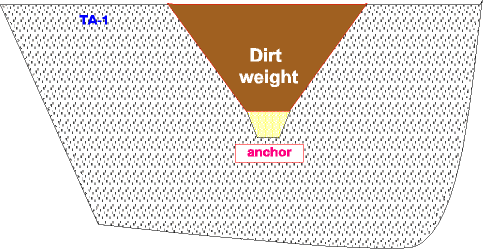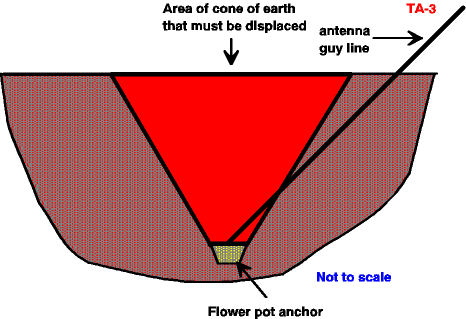Anchors for Guyed Towers


Too often the design of a guyed tower system fails to include the design of the anchors. This article details the construction and implementation of anchors. When I installed my tower more than 10 years ago, I used this technique. It was cheap, simple, and based on good engineering design, and therefore continues to provide safe support.
The holding power of an anchor is dependent on both the size of the anchor and the depth it is buried in the ground. It is the weight of the earth above the anchor that provides the holding force, not the weight of the anchor. Further, standard practice includes the weight of earth in a cone shape above the anchor with the cone angle being 30 degrees relative to vertical as indicated in Figure 1.

This assumes the characteristics of average soil. You will soon see it is very easy to develop a holding force far in excess of the strength of the guy wires, and the type of soil is not important.
If the actual anchor were cone shaped, the total cone size is dependent on depth (D).
The radius (R) is proportional to depth, where :
If the weight of the earth is assumed to be 100 lb./ft.3 and the holding force (F) = volume (V) x weight (W) per unit volume, the holding force (F) = 35 D3.
As an example of anchor depth, since the breaking strength of 1/4 inch steel cable is 5,480 pounds, an anchor buried 5-1/2 feet deep would be sufficient for that cable.
There are many types of anchors commercially available, but it is easy to construct an inexpensive one out of concrete. Put a small loop in the guy cable and secure it with a cable clamp. Through this loop insert two short pieces of concrete reinforcing rod approximately 5 inches long. Use a piece of wire to hold the two rods at right angles. Set this in a 6 inch diameter plastic bucket. Mix enough concrete to fill the bucket, then let it dry for a couple of days before removing it from the bucket. See Figure 2:

Dig the hole for the anchor with a post hole digger to the desired depth. Drop the anchor in the hole and cover it with dirt. When putting dirt in the hole, mix it with water and tamp the dirt. Give it a day or two to settle. An example is below in Figure 3:

When you first apply tension by tightening the guy wires, they will need to align themselves. They will assume an angle and cut their way through the dirt. This will require tightening the guy wires a couple of times until the alignment is complete. While writing this article, it reminded me to check the tension in the guy wires on my tower. I found no significant change after 10 plus years, and the soil here in Florida is pure sand.
Originally posted on the AntennaX Online Magazine by Ted Hart W5QJR
Last Updated : 17th March 2024
